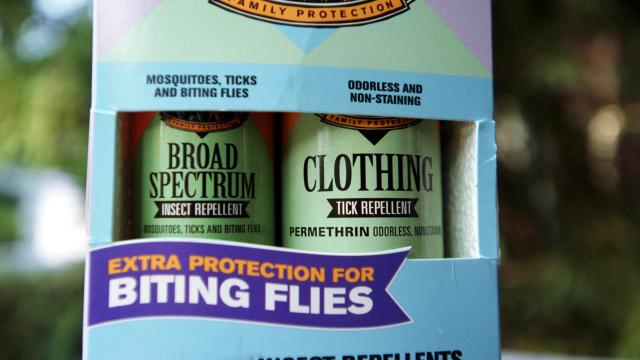A new CDC-led study published today in the Journal of Medical Entomology suggests it might be a great time to invest in a new fashion trend: bug spray-laced clothing. The study found that clothing treated with permethrin was able to stop several species of disease-causing ticks in their tracks, either paralyzing them or making them fall off the clothes.
Permethrin is a common household insecticide derived from a plant that attacks a variety of bugs, including the eight-legged tick and mosquitos. It’s a particularly useful chemical because of its harmlessness to people when applied to the skin. In recent years, as more and more people have started to be sickened by ticks and insects, some companies have begun to offer services that will treat your own clothing with permethrin or to sell pants and shirts already treated with it.
Earlier research by the CDC has shown that permethrin-treated clothing was effective at warding off the black-legged tick (Ixodes scapularis), which is the species most responsible for spreading Lyme disease in the US. In the new study, however, they tested whether it could defend against the black-legged tick as well as two other species, the lone star tick (Amblyomma americanum) and the American dog tick (Dermacentor variabilis), which cause less-common diseases in people, such as southern tick-associated rash illness (STARI) and Rocky Mountain spotted fever, respectively. They also tested permethrin-treated clothing against both nymph and adult ticks (younger nymph ticks are often thought to spread disease more easily, since they feed on our blood for longer periods of time).
The researchers used 10 pieces of clothing from a well-known producer of permethrin-treated clothing, Insect Shield, including shirts, pants, and socks. In one test, they had the clothes propped up vertically while they introduced the ticks, to see if they would fall off; in others, they simply laid the clothes down and exposed the ticks to them for a certain amount of time, ranging from one to five minutes. They then observed these ticks over the next day to see if the chemical had impaired their ability to move and bite.
“All tested tick species and life stages experienced irritation – the ‘hot-foot’ effect – after coming into contact with permethrin-treated clothing,” said senior author Lars Eisen, research entomologist at the CDC’s National Center for Emerging and Zoonotic Infectious Diseases, in a statement. “This caused the ticks to drop off from a vertically oriented treated textile designed to mimic a pant leg or the arm of a shirt.”
All of the ticks, across every stage of life and every species tested, were also physically impaired and unable to bite for at least an hour after five minutes of sustained contact with the clothing. But there were some subtler differences with lower doses. All black-legged nymphs were knocked out after only one minute’s worth of exposure, for instance, while the same was true for 62 per cent of adult female black-legged ticks (both male and female adult ticks can theoretically bite and suck blood from humans, but females are the usual culprit). Only 18 per cent and 2 per cent of American dog tick adult females and lone star tick adult females were affected by the clothing after one minute of exposure, respectively.
The findings are the strongest proof yet that permethrin-treated clothing gets the job done, the researchers say. However, there are still some questions as to how to make the most of these products, as well as how durable their effects are through repeated washes.
“Ultimately, we’d like to be able to provide more specific guidance about the use of permethrin-treated clothing, including what types of clothing provide the best protection,” Eisen said. “Additional research in this area can improve public health recommendations.”
If you’re not willing to go through the hassle of ordering new clothes or having your existing wardrobe specially treated, there are also permethrin sprays you can pick up online. There’s some evidence that this do-it-yourself method might be even better at keeping away certain bugs like mosquitoes. According to the CDC, these sprays should have 0.5 per cent permethrin, and be used to treat clothing such as boots, pants, socks, as well as outdoor camping gear like tents.
